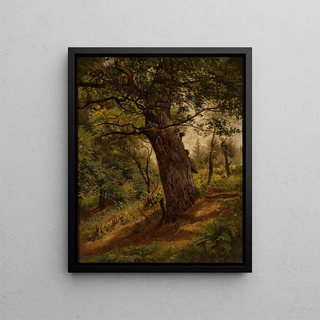Art print | Study of a tree - Wilhelm Peter Bayer


View from behind

Frame (optional)
Wilhelm Peter Bayer’s "Study of a Tree" art print immerses us in a universe where nature and art meet with rare delicacy. This study, far from being a simple representation, is an invitation to contemplate the beauty of organic forms and the complexity of textures. By scrutinizing this work, the viewer is immediately transported into a silent dialogue between the artist and nature, where each brushstroke seems to capture the very essence of the tree. The light, shadows, and shades of green intertwine to create an atmosphere that is both serene and vibrant, demonstrating Bayer’s skill in playing with the elements of his subject.
Style and uniqueness of the art print
Wilhelm Peter Bayer’s style is distinguished by his ability to combine realism and impressionism. In "Study of a Tree," he does not merely faithfully reproduce botanical details; he infuses his work with an almost poetic dimension. The contours of the tree, though precise, appear to blend into an artistic blur that evokes the movement of the wind through the leaves. This approach gives the art print a unique dynamic, where the viewer is invited to feel rather than simply observe. The colors, subtly nuanced, evoke the variations of natural light, paying homage to the fleeting beauty of landscapes. This art print transcends the simple academic exercise to become a true exploration of the emotions that nature can evoke.
The artist and his influence
Wilhelm Peter Bayer, an emblematic figure of his time, knew how to leave a mark on the art world with his singular vision. Trained in prestigious schools, he developed a style that combines tradition and innovation. His works, often inspired by nature, testify to a deep reflection on the interaction between man and his environment. Bayer was influenced by the great masters of impressionism, but he distanced himself to forge a unique identity. His work has had a significant impact on many contemporary artists, encouraging each to reevaluate their relationship with nature. Through his studies, he reminds us of the importance of contemplation and wonder in the face of the beauty of the world around us.

Matte finish

View from behind

Frame (optional)
Wilhelm Peter Bayer’s "Study of a Tree" art print immerses us in a universe where nature and art meet with rare delicacy. This study, far from being a simple representation, is an invitation to contemplate the beauty of organic forms and the complexity of textures. By scrutinizing this work, the viewer is immediately transported into a silent dialogue between the artist and nature, where each brushstroke seems to capture the very essence of the tree. The light, shadows, and shades of green intertwine to create an atmosphere that is both serene and vibrant, demonstrating Bayer’s skill in playing with the elements of his subject.
Style and uniqueness of the art print
Wilhelm Peter Bayer’s style is distinguished by his ability to combine realism and impressionism. In "Study of a Tree," he does not merely faithfully reproduce botanical details; he infuses his work with an almost poetic dimension. The contours of the tree, though precise, appear to blend into an artistic blur that evokes the movement of the wind through the leaves. This approach gives the art print a unique dynamic, where the viewer is invited to feel rather than simply observe. The colors, subtly nuanced, evoke the variations of natural light, paying homage to the fleeting beauty of landscapes. This art print transcends the simple academic exercise to become a true exploration of the emotions that nature can evoke.
The artist and his influence
Wilhelm Peter Bayer, an emblematic figure of his time, knew how to leave a mark on the art world with his singular vision. Trained in prestigious schools, he developed a style that combines tradition and innovation. His works, often inspired by nature, testify to a deep reflection on the interaction between man and his environment. Bayer was influenced by the great masters of impressionism, but he distanced himself to forge a unique identity. His work has had a significant impact on many contemporary artists, encouraging each to reevaluate their relationship with nature. Through his studies, he reminds us of the importance of contemplation and wonder in the face of the beauty of the world around us.






